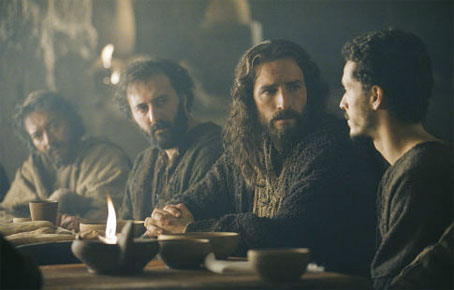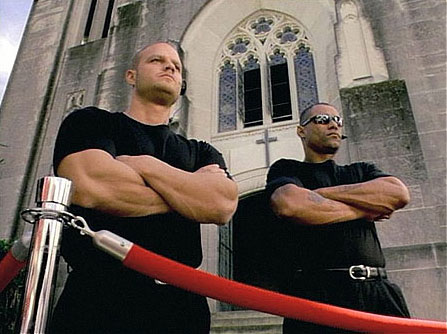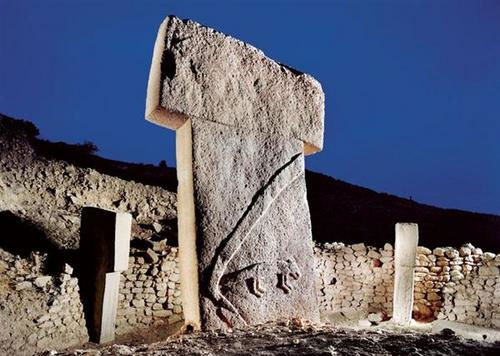Mar
10
2010

or Playing Poison with Genesis 1
You know how it is when you read one of your favourite theologians and they come up with a real clanger? It’s yes, wow, yes, I’m with you, and then the train of thought jumps the tracks—at least as far as you, the reader, are concerned. It’s like me reading a good Presbyterian who without any warning flies off the wall and marries chalk and cheese to prove the Bible teaches infant baptism. Or it’s you reading this blog watching me fly off the wall every now and then (but it’s all completely logical in my mind—believe me! Bully is never wrong!)
Anyhow, J. L. Vaughan, a “Covenant Creationist” on the AV forum pointed out this article by Brian Godawa, who is both a theologian and a screenwriter. I have featured Brian’s articles on the Abrahamic Covenant, Matthew 24 and Daniel 9 on my old The Last Days page. He is logical and easy to understand. And he’s a preterist. But then he jumps the tracks (as far as I’m concerned) and goes and parrots this drivel:
Continue reading
7 comments | tags: Add new tag, Compromise, Covenant Creationism, Genesis, Tas Walker | posted in Creation
Mar
9
2010

or Understanding Apostolic Wine Science
Scholars talk about identifying the “apostolic hermeneutic,” which sounds intimidating. The reason for this phrase is that according to the commonsense rules of interpretation, the apostles are merrily delinquent. They quote many Old Testament texts, rip them out of their historical contexts and claim they are fulfilled in Christ.
Our problem is that the apostles are neither hacks nor mystics. They are authoritative. Some rightly explain that the apostles are just seeing Christ prefigured in the Old Testament Scriptures, which they are, but this explanation is too vague. God’s Word is meticulous.
Continue reading
Comments Off | tags: C. S. Lewis, Hermeneutics, Literary Structure | posted in Biblical Theology
Mar
8
2010

“God’s Cloud over the people forms a Great Booth, within which they live. That Cloud over them is like the glorious canopy of a leafy tree, and thus the reproduction of such an arboreal canopy is a symbol of God’s Cloud.”
An important thread of God’s methodology is His process of bringing us from slavery to Sabbath, from childhood to maturity. It begins with Creation and ends with Glorification.
The Lord speaks the Word from His glory cloud—like the Light created on Day 1—and a stagnant history begins to move forward once again. At the end of the process the Lord returns in His cloud, but it is now made of something even better. The Lord’s robe is no longer a covering of Angels but a covering of redeemed, glorified Men.
In the Tabernacle, the housebuilding process begins with the Ark as “Light” and ends with God’s Cloud—the Shekinah—resting upon it. In the Feasts, it begins with the regular Sabbath as the Creation week and ends with the Feast of Tabernacles, the greater rest. Continue reading
Comments Off | tags: Feasts, James Jordan, Tabernacles | posted in Biblical Theology
Mar
8
2010
Comments Off | tags: Temptation | posted in Christian Life
Mar
3
2010
Band of Brothers – 1

It’s a temptation to water down the Bible to make it palatable for “normal” people (let alone watering it down for ourselves!). Problem is, before we know it, what we are teaching bears little resemblance to the actual Bible. The Bible has odd corners where we think it should be smooth, and it says nothing about many things we moderns deem crucial. So let the hungry eat cake.
Many youth leaders, and even pastors, present the Almighty as being desperate for our company. Although He is not needy, what He desires is more than relationship. He wants “friends,” but His definition of this word is not ours. Even if we don’t go down the track of using the actual phrase “heavenly buddy” in our teaching, we are still further off the biblical mark concerning friendship with God than we might have thought possible.
Continue reading
Comments Off | tags: Abraham, Compromise, David, Joseph, Masculinity, Saul | posted in Biblical Theology, Christian Life
Mar
2
2010
or Meat to Eat – 2

[From last time] …Under this new Levitical Law, a new “Garden” would be constructed, and a great many animals would be slaughtered and offered within its insatiable boundary. It was a King’s Table. Yahweh was already Omega, already Solomon. But Israel, not yet humble, desired Omega food, the food of “ascension.” Not satisfied with the bread of “priestly” obedience, they lobbied for meat to eat.
“So it was that quails came up at evening and covered the camp, and in the morning the dew lay all around the camp.” —Exodus 16:13
We mentioned that bread is Alpha food. Wine, and sometimes meat, are Omega foods. Firstfruits and Pentecost are about grain. Tabernacles is about the grape and olive harvests. This final feast is also the one where the Lord says if you want to carve up an ox or feel like strong drink, knock yourself out (ie. spare no expense).
Continue reading
Comments Off | tags: Exodus, Herod, Moses, Numbers | posted in Biblical Theology, The Last Days
Mar
1
2010
The Bible vindicated yet again, by a site that dwarfs Pompeii

Ben Witherington comments on the unearthing of a huge temple complex and its relevance to Genesis:
This temple lies west of the Biblical plain called Haran and is only 20 miles from the Syrian border. This places it right in the fertile crescent which begins below modern day Iraq, includings the Tigris and Euphrates rivers and winds its way north through Syria and into eastern Turkey. This is the world not only of Genesis, but of the great Anatolian civilization of the Hittites (yes those Hittites as in Uriah the Hittite—husband of Bathsheba)… Klaus Schmidt and his team of Kurdish diggers have uncovered an enormous temple complex that pre-dates the Great Pyramids by some 7,000 years and Stonehenge by at least 6,000 years!… After 12 years of hard work, Schmidt has found at least four temple complexes. The radar scans of the area indicate there is a huge amount more to uncover here. And Schmidt has a thesis about this temple complex—here is a short excerpt from the Newsweek article on this:
“Schmidt’s thesis is simple and bold: it was the urge to worship that brought mankind together in the very first urban conglomerations. The need to build and maintain this temple, he says, drove the builders to seek stable food sources, like grains and animals that could be domesticated, and then to settle down to guard their new way of life. The temple begat the city.”
The importance of this find for Biblical thinking is this—the Bible says that from the outset, human beings were created in God’s image. Human beings were religious creatures from Day One. Archaeologists and sociologists have long dismissed this theory saying organized religion comes much later in the game than the beginning of civilization and city building. As Ian Holder director of Stanford’s prestigous archaeology program says— this is a game changer. Indeed, it changes everything experts in the Neolithic era have been thinking. Schmidt is saying that religion is the cause of civilization, not the result of it. Towns were built to be near the Temple complex. Agriculture was undertaken to feed those living there and supply the temple complex, and so on. The first instincts of humans were to put religion first. Maybe there is more to that Genesis story than some have been willing to think or admit. Maybe human beings are inherently homo religiosis.
Continue reading
Comments Off | tags: Archaeology, Ben Witherington, Genesis, The flood | posted in Creation, Quotes
Feb
27
2010

Some great quotes from an interview by Barbara Demarco-Barrett with author Mary Karr:
“[My young son] came flouncing in in his Power Ranger pyjamas and said “I wanna go to church.” I said “Why?” and he said, “To see if God’s there.” It was about the only sentence he could have said that would have gotten me to go. So we did this thing we called God-a-rama in which we went to various temples and mosques and zendos. I had no interest in going to church so I brought a latté and a paperback.
Continue reading
4 comments | tags: Conversion, Faith, Poetry, Prayer, Roman Catholicism | posted in Christian Life, Quotes
Feb
25
2010
Descending Theology: The Resurrection
BY MARY KARR
From the far star points of his pinned extremities,
cold inched in—black ice and squid ink—
till the hung flesh was empty.
Lonely in that void even for pain,
he missed his splintered feet,
the human stare buried in his face.
He ached for two hands made of meat
he could reach to the end of.
In the corpse’s core, the stone fist
of his heart began to bang
on the stiff chest’s door, and breath spilled
back into that battered shape. Now
it’s your limbs he comes to fill, as warm water
shatters at birth, rivering every way.
1 comment | tags: Poetry, Resurrection | posted in Quotes
Feb
25
2010

From Peter Leithart’s blog:
Jay McInerny reviews First Chapter: How to Talk About Books You Haven’t Read by Pierre Bayard in the NYT. He says in part:
Continue reading
Comments Off | tags: Culture, Peter Leithart | posted in Christian Life, Quotes

































